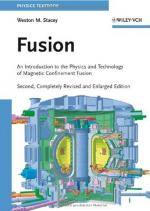|
This section contains 325 words (approx. 2 pages at 300 words per page) |
Fusion is a nuclear process in which two atoms are combined to create a different atom (and some by-products). Magnetic confinement fusion uses a magnetic field to compress and heat gases into the plasma state so that fusion can take place. Plasma is a fourth state of matter not usually observed as a natural state on Earth; it exists as a natural state in stars. It is a state where the atoms of the gas have been stripped of their electrons so that the electrons, protons, and neutrons are free to interact. Very high temperatures, on the order of 15,0x106 K, are needed to overcome nuclear forces, which hold individual atoms together, and atomic forces, which keep two atoms apart, and for fusion to take place. The magnetic field containing the plasma can be manipulated in order to increase the pressure, thereby increasing the temperature.
The most common confinement shape is that of a toroid, or doughnut. This design is called the Tokamak class of fusion reactor and is originally of Russian design. Magnetic fields run along the doughnut as well as around it. The charged plasma then follows a helical pattern inside the toroid.
The plasma is made of a superheated gas, such as a mix of deuterium and tritium, which are isotopes of hydrogen. It is pumped into an evacuated chamber and heated in pulses. Eventually, the temperature is high enough for the fusion process. At this point, the plasma gives off energy and cools. Another pulse is then applied to the plasma and fusion occurs again. The cycle of heating and discharge continues until the fuel is exhausted. This is a rather inefficient form of fusion, since almost as much energy is put in as is given off by the plasma. Eventually, scientists wish to find a self-heating reaction that will sustain the fusion process, such as the nuclear ignition seen in the core of stars.
|
This section contains 325 words (approx. 2 pages at 300 words per page) |


